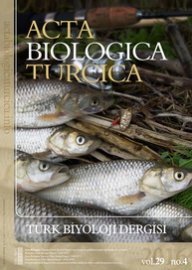Spermatophore weight and sperm number in the southernmost species of the genus Poecilimon Fischer, 1853 (Orthoptera: Phaneropterinae)
Abstract
Male bushcrickets transfer during copulation edible spermatophores that are consumed by bushcricket females as nutrient sources. They consist of two edible parts; the smaller ampulla that contains the ejaculate and the larger spermatophylax. Both components of the spermatophore and the number of sperm transferred vary greatly in size respectively number between species. This paper examines the relationship between body size and spermatophore components, including sperm number in Poecilimon (Poecilimon) syriacus Brunner von Wattenwyl, 1891 which is known from the southernmost area of the genus distribution. Water content of spermatophylax was found to be about 90% of wet mass. Consistent with many previous studies, the spermatophore components, including dry spermatophylax weight, were positively affected by male body weight, but there was no relationship between body weight and sperm number. A positive relationship between wet spermatophylax weight and ampulla weight supports the ejaculate protection hypothesis. The results of this study suggest that P. syriacus makes a large investment in spermatophylax and ampulla relative to its body size in comparison to other species of the genus Poecilimon.
Keywords
Full Text:
PDFReferences
Alcock J. 2013. Animal Behavior: An Evolutionary Approach, Tenth edn. Sinauer Associates, 522 p.
Blanckenhorn W.U., Demont M. 2004. Bergmann and converse Bergmann latitudinal clines in arthropods: Two ends of a continuum? Integrative Comparative Biology, 44: 413-424.
Blanckenhorn W.U., Hellriegel B. 2002. Against Bergmann's rule: fly sperm size increases with temperature. Ecology Letters, 5: 7-10.
Çıplak B., Demirsoy A., Yalim B., Sevgili H. 2002. Türkiye'nin Orthoptera (Çekirgeler= Düzkanatlılar) faunası, In: A. Demirsoy (Ed). Genel Zoocoğrafya ve Türkiye Zoocoğrafyası: Hayvan Coğrafyası Meteksan, Ankara, pp. 681-707.
Davidowitz G., Nijhout H.F. 2004. The physiological basis of reaction norms: The interaction among growth rate, the duration of growth and body size. Integrative and Comparative Biology, 44: 443-449.
Eades D.C., Otte D., Cigliano M.M., Braun H. 2015. Orthoptera Species File, Version 5.0/5.0., retrieved, 28.01.2016.
Eweleit L., Reinhold K. 2014. Body size and elevation: do Bergmann's and Rensch's rule apply in the polytypic bushcricket Poecilimon veluchianus?. Ecological Entomology, 39: 133-136.
Gwynne D.T. 2001. Katydids and Bush-Crickets: Reproductive Behavior and Evolution of the Tettigoniidae. Cornell University, USA, 317 p.
Heller K.G., Faltin S., Fleischmann P., von Helversen O. 1998. The chemical composition of the spermatophore in some species of phaneropterid bushcrickets (Orthoptera: Tettigonioidea). Journal of Insect Physiology, 44: 1001-1008.
Heller K.G., Reinhold K. 1994. Mating effort function of the spermatophore in the bush-cricket Poecilimon veluchianus (Orthoptera, Phaneropteridae) support from a comparison of the mating-behavior of 2 subspecies. Biological Journal of the Linnean Society, 53: 153-163.
Heller K.-G., Sevgili H., Reinhold K. 2008. A re-assessment of the Poecilimon syriacus group (Orthoptera Tettigonioidea, Phaneropteridae) based on bioacoustics, morphology and molecular data. Insect Systematics and Evolution, 39: 361-379.
Lamunyon C.W. 1997. Increased fecundity, as a function of multiple mating, in an arctiid moth, Utetheisa ornatrix. Ecological Entomology, 22: 69-73.
Lehmann G.U.C. 2012. Weighing costs and benefits of mating in bushcrickets (Insecta: Orthoptera: Tettigoniidae), with an emphasis on nuptial gifts, protandry and mate density. Frontier Zoology, 9.
Lehmann G.U.C., Lehmann A.W. 2008a. Bushcricket song as a clue for spermatophore size?. Behavioral Ecology and Sociobiology, 62: 569-578.
Lehmann G.U.C., Lehmann A.W. 2008b. Variation in body size among populations of the bushcriket Poecilimon thessalicus (Orthoptera: Phaneropteridae): an ecological adaptation?. Journal of Orthoptera Research, 17: 165-169.
Lehmann G.U.C., Lehmann A.W. 2016. Material benefit of mating: the bushcricket spermatophylax as a fast uptake nuptial gift. Animal Behavior, 112: 267-271.
McCartney J., Heller K.-G., Potter M.A., Robertson A.W., Telscher K., Lehmann G., Lehmann A.W., Von Helversen D., Reinhold K., Achmann R. 2008: Understanding the size of nuptial gifts in bush-crickets: an analysis of the genus Poecilimon (Tettigoniidae: Orthoptera). Journal of Orthoptera Research, 17: 231-242.
Pauchet Y., Wielsch N., Wilkinson P.A., Sakaluk S.K., Svatos A., Ffrench-Constant R.H., Hunt J., Heckel D.G. 2015. What's in the gift? Towards a molecular dissection of nuptial feeding in a cricket. PLoS ONE, 10: e0140191.
Reinhold K. 1999. Paternal investment in Poecilimon veluchianus bushcrickets: beneficial effects of nuptial feeding on offspring viability. Behavioral Ecology and Sociobiology, 45: 293-299.
Reinhold K., von Helversen D. 1997. Sperm number, spermatophore weight and remating in the bushcricket Poecilimon veluchianus. Ethology, 103: 12-18.
Roff D. 1980. Optimizing development time in a seasonal environment: the ‘ups and downs’ of clinal variation. Oecologia, 45: 202-208.
Şensoy S., Demircan M., Ulupınar Y. 2016. Climate of Turkey. MGM Web site. Turkish State Meteorological Service. http://www.mgm.gov.tr/files/en-us/climateofturkey.pdf
Sevgili H., Çıplak B. 2000. The Orthoptera of Şanlıurfa province from the Mesopotamian part of Turkey. Italian Journal of Zoology, 67: 229-240.
Sevgili H., Önal H., Yigit A. 2015. Mating behavior and spermatophore characteristics in two closely related bushcricket species of the genus Phonochorion (Orthoptera: Phaneropterinae). Journal of Insect Behavior, 28: 369-386.
Simmons L.W. 2001. Sperm competition and its evolutionary consequences in the insects. Princeton University Press, Princeton, NY, 456 pp.
Team R.D.C. 2009. R: A Language and Environment for Statistical Computing. R foundation for statistical Computing, Vienna, Austria.
Uma R., Sevgili H. 2015. Spermatophore allocation strategy over successive matings in the bushcricket Isophya sikorai (Orthoptera Phaneropterinae). Ethology, Ecology and Evolution, 27: 129-147.
Vahed K. 1998. The function of nuptial feeding in insects: review of empirical studies. Biological Reviews of the Cambridge Philosophical Society, 73: 43-78.
Vahed K., Gilbert F.S. 1996. Differences across taxa in nuptial gift size correlate with differences in sperm number and ejaculate volume in bushcrickets (Orthoptera: Tettigoniidae). Proceedings of the Royal Society B-Biological Sciences, 263: 1257-1265.
Voigt C.C., Michener R., Kunz T.H. 2005. The energetics of trading nuptial gifts for copulations in katydids. Physiological and Biochemical Zoology, 78: 417-423.
Wedell N. 1994. Variation in nuptial gift quality in bush-crickets (Orthoptera, Tettigoniidae). Behavioral Ecology, 5: 418-425.
Wedell N., Arak A. 1989. The wartbiter spermatophore and its effect on female reproductive output (Orthoptera, Tettigoniidae, Decticus verrucivorus). Behavioral Ecology and Sociobiology, 24: 117-125.
Refbacks
- There are currently no refbacks.

